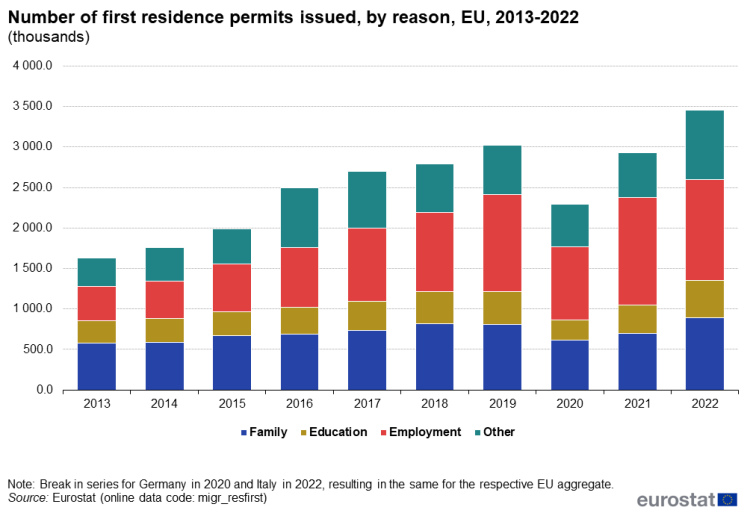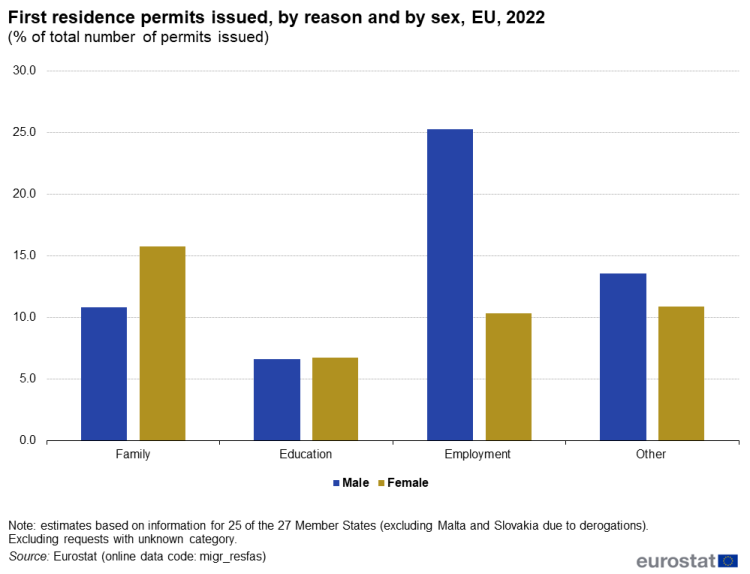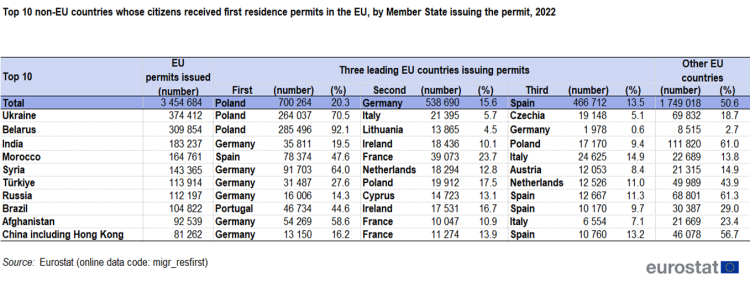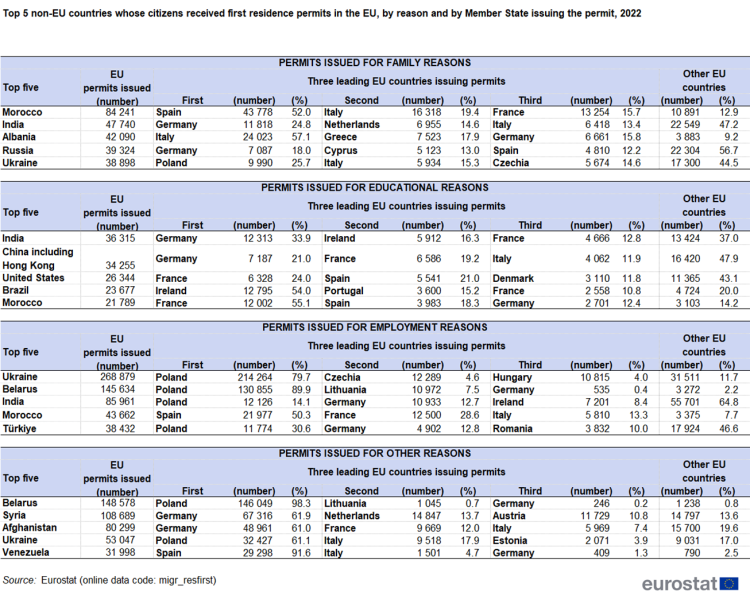Residence permits - statistics on first permits issued during the year
Data extracted in 5 January 2024.
Planned article update: August 2024.
Highlights
In 2022, about 3.5 million first residence permits were issued in the EU to non-EU citizens, a 17.8 % increase (+521 536 permits) compared with 2021.
In 2022, among the 10 top citizenships of non-EU nationals who received first residence permits, the highest relative increases compared with 2021 were observed for Syria (up 123.5 %), Belarus (108.1 %) and Afghanistan (84.4 %).
In 2022, employment was the main reason for non-EU citizens obtaining first residence permits in the EU (1.2 million first residence permits or 35.9 % of all first permits).
Number of first residence permits issued by reason, EU, 2013-2022
This article presents European Union (EU) statistics on first residence permits issued to non-EU citizens during the reference year 2022. Data are based on the regulatory framework provided by Article 6 of Regulation (EC) No 862/2007 on migration and international protection statistics.
A residence permit is an authorisation issued by the competent national authority allowing a citizen of a non-member (non-EU) country (also known as a third country national) to stay for at least three months on its territory. Data on residence permits are collected together with information on the reasons for issuing such permits. The main reasons include: employment, family reunification and education, with a residual category for ‘other reasons’. Persons benefitting from temporary protection, i.e. persons who left Ukraine due to Russia’s invasion, are not covered by the data on residence permits; see the methodological section below.
The change in the number of residence permits issued in individual EU countries reflects the diversity of national migration systems and the impact of European immigration policy. Other factors, such as the characteristics of citizens of non-member countries, legal frameworks and the characteristics of countries involved in the immigration process — such as their geographical proximity or language ties — can also be important.
National administrative registers and databases are the main sources for these statistics.
Full article
First residence permits — an overview
In 2022, almost 3.5 million first residence permits were issued in the EU to citizens of non-member countries.[1].
This latest value was a record high — since records began — representing a 17.8 % increase (or additional 521 536 permits) when compared with data for 2021 (see Figure 1). It should be noted, that this figure does not include persons granted authorisation to reside and benefiting from temporary protection status for which statistics are collected under a separate data collection framework. For more detailed information please refer to the Eurostat database.

(thousands)
Source: Eurostat (migr_resfirst)
The increase from 2021 to 2022 in the total number of first residence permits was mainly due to an increased number of first permits issued for other reasons (300 727 permits more, or +53.7 %), family (199 068 permit more, or +28.6 %) and education reasons (103 403 permit more, or +29.3 %). Permits issued for employment reasons saw a decrease in comparison with the year 2021 (81 662 permits less, or -6.2 %).
In 2022, around 1.2 million first-residence permits were issued for employment-related reasons, which was the highest absolute number in relation to the remaining categories, representing 35.9 % of all first residence permits issued. Family reasons accounted for 25.9 %, education reasons for 13.2 %, while other reasons, including international protection, accounted for 24.9 %.

(thousands)
Source: Eurostat (migr_resfirst)
Among the EU countries, Poland led the list of first residence permits granted in the EU to non-EU citizens, issuing 700 264 permits (or 20.3 % of total permits issued in the EU). More than 300 000 first permits were also issued by Germany with 538 690 permits (or 15.6 %), Spain with 466 712 (or 13.5 %), Italy with 337 788 (or 9.8 %) and France with 324 200 (or 9.4 %). These five countries accounted for almost 70 % of all first residence permits issued in the EU in 2022.
The largest relative increase in the total number of first permits issued in 2022 when compared with 2021 was recorded in Germany: +190.3 % (from 185 570 in 2021 to 538 690 in 2022). Among the top citizenships receiving first residence permits in Germany in 2022 were Syrians and Afghans who saw significant increases compared with 2021 (around 70 000 and 41 000 more permits respectively), the main contributors to the overall rise. The increase in Germany was mainly due to an increased number of permits issued for family and other reasons. Germany was followed by Malta (+163.6 %; from 14 358 to 37 851) and Ireland (+145.6 %; from 34 935 to 85 793).
The largest relative decreases in the total number of permits issued in 2022 when compared with 2021 were recorded in Czechia (-27.7 %; from 74 395 in 2021 to 53 809 in 2022) and Poland (-27.6 %; from 967 345 to 700 264).
Compared with the population of each Member State (2022 average population), the highest ratios of first residence permits per 1 000 population in 2022, were recorded in Malta (71.3 permits issued per 1 000 population) and Cyprus (42.6). The lowest ratios were observed in Romania (2.2), Bulgaria (2.4) and Greece (3.4). In total in the EU as a whole, there were 7.7 first residence permits issued per 1 000 population in 2022.

(per 1 000 population)
Source: Eurostat (migr_respop)
First residence permits by reason
Remunerated activities
In 2022, employment reasons were the most common reason for issuing residence permits in 14 Member States. The highest shares were observed in Croatia (93.3 %), Romania (73.6 %), Malta (72.8 %), Lithuania (71.5 %) and Slovakia (70.5 %), (see Table 1). Poland with 447 225 first permits was the main destination for non-EU citizens (mainly Belarusians and Ukrainians) entering the EU for work reasons. The next most common destinations for work were Spain (140 034 permits) and Germany (81 795 permits). These three Member States issued more than a half of all first permits for employment reasons in the EU (53.9 %).
Family formation and reunification
Family-related reasons were the most common reason for issuing residence permits in nine Member States. In Belgium, Luxembourg, Greece and Sweden, family-related reasons accounted for more than 40 % of all the permits issued at national level. Germany (188 367), Spain (174 532), Italy (131 275) and France (96 598) were the EU countries with the highest number of first residence permits issued in 2022 for family-related reasons; these four countries accounted for almost two-thirds of all first permits for family-related reasons in the EU (65.9 %).
Education and study
Ireland and France were the only two EU countries where the most common reason for granting a residence permit was education-related, respectively 48.4 % and 32.3 %. Notably, France emerged as the top choice for non-EU students seeking educational opportunities within the EU. During 2022, there were 104 777 first residence permits issued in France for education-related reasons; this represented 22.9 % of all the permits issued for education-related reasons in the EU. France was followed by Germany (70 072) and Spain (58 418).
Other reasons
Table 1 also shows the number of first residence permits issued for other reasons, such as international protection, residence without the right to work (e.g. pensioners). A country comparison based on this miscellaneous category is hampered by the differences that exist in national administrative and legislative systems. This category also covers some specific statuses that only exist under national legislation — for example, in Poland, holders of the Pole’s card are registered in this category (for more information, please see the national metadata file). Austria and Germany were the only two EU countries where the most common reasons for granting a residence permit were other reasons, respectively 50.1 % and 36.8 % of all the permits issued at national level.
First residence permits by sex
An analysis based on the results available for 25 of the EU countries[2] reveals some differences between the sexes as regards their principal reasons for obtaining a residence permit (see Figure 4). In 2022, based on available data, the primary reason for issuing a first residence permit to males was for employment-related reasons (25.3 % of the total), while the corresponding share for females was lower and accounted for 10.4 %. In contrast, 15.7 % of all permits issued were for females who were granted residence permits for family-related reasons; this share was higher than the corresponding proportion recorded for males (10.8 %). Almost the same amount of permits for education - related reasons were delivered to males and females, respectively 6.6 % and 6.7 %.

(% of total number of permits issued)
Source: Eurostat (migr_resfas)
First residence permits by citizenship and by destination in the EU
In 2022, citizens of Ukraine (374 412, or 10.8 % of the total number of first residence permits issued in the EU) received the highest number of first residence permits, ahead of citizens of Belarus (309 854, or 9.0 %) and India (183 237, or 5.3 %). Around a half (48.6 %) of all first residence permits issued in the EU in 2022 were issued to citizens of the top 10 countries presented in Figure 5.

(thousands)
Source: Eurostat (migr_resfirst)
Figure 5 also shows the development of the number of first residence permits that were issued between 2020 and 2022 for the 10 top citizenships of non-EU citizens. The ranking in top 10 citizenships that were granted first residence permits remained almost unchanged between 2021 and 2022. The only significant change in the ranking is that the number of citizens of the United States dropped and citizens of Afghanistan were included in the top 10.
In 2022 compared with 2021, among the 10 top citizenships of non-EU citizens who received first residence permits, the highest relative increases were observed for Syria (123.5 %), Belarus (108.1 %) and Afghanistan (84.4 %). Only in the case of Ukraine did the number of first residence permits issued shrink by 57.1 %, which can be explained by the effects of Russia’s invasion of this country and the large number of Ukrainians granted temporary protection in 2022 (which is not covered by statistics on residence permits and can be seen in statistics on temporary protection).
There are several factors that influence the destination chosen by citizens of non-EU countries granted residence permits, these include: geographical proximity (for example, a high number of Belarusians sought residence in Poland, a high number of Russians - in Finland and a high number of Moroccans - in Spain and France); historical and linguistic links (for example, a high number of Venezuelans, Colombians, Peruvians and Hondurans sought residence in Spain, a high number of Moroccans, Algerians and Tunisians in France, and a high number of Brazilians, Angolans and Cape Verdeans sought residence in Portugal); or an established migrant networks (for example, a high number of Turkish citizens sought residence in Germany) — see Table 2.

Source: Eurostat (migr_resfirst)
Poland was the principal destination for Ukrainian citizens, as 70.5 % of all resident permits issued to Ukrainians in the EU in 2022 were issued in Poland (see Table 3). In a similar vein, the principal destination for citizens of Belarus was also Poland (92.1 % of all resident permits issued to citizens of Belarus in the EU). Portugal was the most popular destination for citizens of Brazil, while Spain was for citizens of Morocco, accounting for 44.6 % and 47.6 %, respectively, of all the resident permits issued to citizens of these countries by the EU. Notably, of the top 10 countries whose citizens received first residence permits in 2022, Germany emerged as the most favored destination for citizens of India, Syria, Türkiye, Russia, Afghanistan and China.

Source: Eurostat (migr_resfirst)
Figure 6 looks in more detail at the reasons for granting permits to citizens of particular countries. Around 7 out of 10 Ukrainians who were granted a residence permit in the EU in 2022 received their permit for employment-related reasons. Employment was also the principal reason for granting residence permits in the EU to Indians (46.9 %) and Turks (33.7 %). Family was the prevailing reason for permits granted to Moroccans (51.1 %), Brazilians (35.3 %) and Russians (35.0 %). Permits for education were primarily issued to Chinese (42.2 %) and other reasons were predominant for Afghans (86.8 %), Syrians (75.8 %) and Belarusians (48.0 %).

(%)
Source: Eurostat (migr_resfirst)
Table 4 focuses on the top five countries whose citizens received first residence permits in the EU by reason and by leading Member States issuing a permit. In 2022, Ukrainians and Belarusians were granted the largest number of residence permits in the EU for employment-related reasons, of which the vast majority were granted in Poland. Moroccans were the largest group to receive residence permits for family-related reasons (mostly in Spain), and Indians were the largest group to receive residence permits for education-related reasons, about a third of which were issued in Germany. Belarusians also topped the list of permits issued for other reasons, of which 98.3 % were granted in Poland.

Source: Eurostat (migr_resfirst)
Source data for tables and graphs
Data sources
The statistics used for this article are provided to Eurostat by the responsible authorities in each of the Member States and EFTA countries, principally Ministries of the Interior or Home Affairs or various immigration agencies. The data are based entirely on administrative sources supplied to Eurostat as part of an annual residence permits data collection exercise in accordance with the provisions of Article 6 of Regulation (EC) No 862/2007 on Community statistics on migration and international protection. Commission Regulation (EU) No 216/2010 implementing Regulation (EC) No 862/2007 gives the definitions of the reasons for the residence permits statistics.
Limitations in data availability affect the information presented in this article:
- Break in series for Germany in 2020 (all reasons) and Italy in 2022 (other reasons).
- For first residence permits issued by sex, data for Malta and Slovakia are not available due to derogations. The unknown category for sex is not included in the totals.
The data on residence permits may be analysed by: reporting country, citizenship of the permit holder, reason for the permit being issued, and length of validity of the permit. From reference period 2010 onwards, data on residence permits were collected on a voluntary basis by age and by sex, becoming mandatory data collection for the 2021 reference period onwards.
Residence permits statistics are available as both flows and stocks.
- Data related to residence permits granted during the reference year (flows): the data published under this category contain information about first residence permits issued during the reference year and information about any change of residence status of immigrants during the reference year;
- Data related to residence permits valid at the end of the reference year (stock of permits): the data published under this category contain information about the number of valid permissions to stay at the end of the reference year and long-term legal residence status at the end of the reference year.
It should be noted that certain methodological aspects are not fully harmonised between the reporting countries due to different legal or information technology systems. Therefore, the results that are presented in this article should be interpreted with care and readers are advised to make reference to the metadata file on residence permits statistics. Some of the main methodological and administrative differences are noted below.
- The "u" flag in Irish data highlights limited data quality reported by the Irish authorities. The process of generating residence permits data involves both the Irish Police and the Department of Justice for which an old information system is currently used. The current system's limitations, which omits unique identifiers of persons, and requires manual data checks, may lead to potential quality issues. According to Irish authorities a comprehensive modernisation programme of the information systems to ensure more accurate data management is in progress.
- The data for France are labeled as provisional for most categories, except for family-related reasons.
Starting with the 2021 reference period, there were several improvements in the data collection, including the methodological aspects. These changes were introduced through the implementation of Regulation 851/2020 amending Regulation 862/2007. More details are available in the following document: 2021 Residence Permits Technical Guidelines.
Methodological note
Residence permits data collection refers to residence permits as any authorisation issued by the authorities of a Member State allowing a third-country national (non-EU citizen) to stay legally on its territory. Temporary protection status is considered to be of a different administrative nature to that of the authorisations to reside reported in residence permits data collection. Therefore, persons benefitting from temporary protection are not included in any of the Residence permits statistics. These persons are subject of a separate data collection on Temporary Protection (TP); see data on temporary protection here and the statistics explained article here. Therefore, while Ukrainians with temporary protection status are not covered in residence permits statistics, those Ukrainians granted residence permits for employment related reasons, family or education - related reasons (but not benefitting from temporary protection) are reported in this data collection.
Context
Migration policies within the EU are built upon solidarity and responsibility, taking into account the contribution that immigrants make to the EU. Within the European Commission, the Directorate-General for Migration and Home Affairs is responsible for immigration policy. In September 2020, the European Commission presented the New Pact on Migration and Asylum. This pact provides a comprehensive approach, bringing together policy in the areas of migration, asylum, integration and border management, recognising that the overall effectiveness depends on progress on all fronts. It creates faster, seamless migration processes and stronger governance of migration and borders policies, supported by modern IT systems and more effective agencies. It aims to reduce unsafe and irregular routes and promote sustainable and safe legal pathways for those in need of protection. It reflects the reality that most migrants come to the EU through legal channels, which should be better matched to EU labour market needs. All relevant legal acts and information regarding the EU’s immigration policy can be accessed on the European Commission’s website.
Notes
- ↑ Data on first residence permits statistics are collected based on the regulatory framework provided by Article 6 of Regulation (EC) No 862/2007 on migration and international protection statistics. There is a break in series for Germany in 2020 (all reasons) and Italy in 2022 (other reasons), resulting in the same for the respective EU aggregate.
- ↑ Residence permits statistics analysed by sex are collected based on the regulatory framework provided by Article 6 of Regulation (EC) No 862/2007 on migration and international protection statistics. Data for 2022 were not provided by the following Member States: Malta and Slovakia due to derogations.
Direct access to
- Residence permits — a methodological and analytical overview
- Residence permits - statistics on stock of valid permits at the end of the year
- Children in migration - residence permits for family reasons
- Asylum applications - annual statistics
- Statistics on countries responsible for asylum applications (Dublin Regulation)
- Enforcement of immigration legislation statistics
- Migrant integration statistics
- Migration and migrant population statistics
- Residence permits (migr_res)
- Residence permits by reason, length of validity and citizenship (migr_resval)
- First permits by reason, length of validity and citizenship (migr_resfirst)
- First permits issued for family reasons by reason, length of validity and citizenship (migr_resfam)
- First permits issued for education reasons by reason, length of validity and citizenship (migr_resedu)
- First permits issued for remunerated activities by reason, length of validity and citizenship (migr_resocc)
- First permits issued for other reasons by reason, length of validity and citizenship (migr_resoth)
- Change of immigration status permits by reason and citizenship (migr_reschange)
- All valid permits by reason, length of validity and citizenship on 31 December of each year (migr_resvalid)
- Long-term residents by citizenship on 31 December of each year (migr_reslong)
- Single permits issued by type of decision, length of validity (migr_ressing)
- Long-term residents among all non-EU citizens holding residence permits by citizenship on 31 December (%) (migr_resshare)
- Long-term residence permits issued during the year (migr_resltr)
- First permits issued for family reunification with a beneficiary of protection status (migr_resfrps1)
- Permits valid at the end of the year for family reunification with a beneficiary of protection status (migr_resfrps2)
- Residence permits by reason, age, sex and citizenship (migr_resage)
- First permits by reason, age, sex and citizenship (migr_resfas)
- All valid permits by age, sex and citizenship on 31 December of each year (migr_resvas)
- Long-term residents by age, sex and citizenship on 31 December of each year (migr_reslas)
- EU blue cards (migr_resbcard)
- EU blue cards by type of decision, occupation and citizenship (migr_resbc1)
- Admitted family members of EU blue card holders by type of decision and citizenship (migr_resbc2)
- EU blue card holders and family members by Member State of previous residence (migr_resbc3)
- Residence permits for intra-corporate transfer (migr_resictra)
- Intra-corporate transferee permits issued, renewed and withdrawn by type of permit, length of validity and citizenship (migr_resict1_1)
- Intra-corporate transferee permits issued by type of permit, economic sector and citizenship (migr_resict1_2)
- Intra-corporate transferee permits issued by type of permit, length of validity, transferee position and citizenship (migr_resict1_3)
- Authorisation for the purpose of the seasonal work (migr_resseaw)
- Authorisations for the purpose of seasonal work by status, length of validity, economic sector and citizenship (migr_ressw1_1)
- Authorisations issued for the purpose of seasonal work by economic sector, sex and citizenship (migr_ressw2)
- Residence permits - Students and Researchers (migr_ressr)
- Authorisations for study and research by reason, type of decision, citizenship and length of validity (migr_ressrath)
- Residence permits by reason, length of validity and citizenship (migr_resval)
- Residence permits (migr_res)
- Residence permits (ESMS metadata file — migr_res_esms)
- European Commission — a New Pact on Migration and Asylum
- European Commission — DG Migration and Home Affairs — Policies
- European Commission — EU Immigration Portal (EUIP) (also available in Arabic, Spanish, French and Portuguese)
- European Commission — European Migration Network (EMN)
- European Commission — website on migrant integration (also available in German and French)
- OECD — Migration (also available in French)
- OECD — International Migration Outlook (also available in French)
